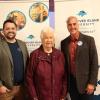October 14, 2008 - 2:03am
After experiencing a heart attack last year, Diane Shipclark, an administrative assistant in Vancouver Island University’s office of the Vice President Administration & Finance, can add “survivor” to her resume. Shipclark was an independent, outgoing 56-year-old, so when she decided to go camping by herself one weekend in July 2007, it wasn’t out of character. When she left for her trip she felt tired and weak, and even had to have a friend set up camp for her, but Shipclark, who was well aware of the signs of a heart attack, did not interpret her symptoms as something as serious as a heart problem.
Twenty years before this camping trip, Shipclark had gone to see a heart specialist after having chest pain and pain in her left arm on many occasions. She was told it was not her heart, that it was most likely acid reflux.
After the doctor’s diagnosis, Shipclark was still anxious about her chest pain, but resigned herself to the fact that she would have to live with the pain.
Many years later, and just three years prior to her heart attack, Shipclark found herself becoming short of breath quite easily. She could not even walk up stairs without losing her breath. She went straight to the doctor and after wearing a heart monitor for 24hrs, was told that she had high blood pressure and high cholesterol. Shipclark was given medication for her condition, and it was mentioned that both physical activity and a diet change would improve her health.
“I didn’t think it was that serious, though. The doctors didn’t make it seem like a big deal, so I thought the medication was all I needed,” says Shipclark. So, even though she had two major risk factors for heart attack, Shipclark did not quit smoking, take up regular physical activity, or change her diet.
Fatigue began to plague Shipclark about six months before her heart attack. “I was just tired all the time,” she says. But because these weren’t classic signs of a heart problem, and she was on medication, Shipclark was not too concerned. Shipclark knew many women around her age had similar complaints.
Six months later, when she went camping, Shipclark was in denial. On the second day of camping, Shipclark felt awful and spent most of the day resting. By day three, she felt so tired and terrible that she couldn’t even get out of her chair when her daughter came to visit. Shipclark’s daughter insisted they go to the hospital. On the way, they stopped at Shipclark’s sister’s house, and the visit left Shipclark so exhausted that she decided she would be better off to go home and go to bed.
The next morning Shipclark was home alone and had to call the ambulance. “I felt like there was a 2000 ton truck sitting on my chest,” she says.
At the hospital, Shipclark was told that she had had a heart attack and there were three blockages in her heart, all under 90 per cent, though. Although her condition called for angioplasty, Shipclark’s high blood pressure dictated that she would need open heart surgery.
“I was a wreck. I didn’t really understand that they would actually have to cut my chest open,” she remembers.
The road to recovery was not an easy one for Shipclark. “I went into a deep, dark depression,” she says. “It was total fear.”
The usually upbeat 57-year-old was taken aback by her anxiety. “I had not been warned at all,” says Shipclark.
Luckily both of Shipclark’s sisters live in Nanaimo, and Shipclark was able to spend her days with one or the other. She also went through some counseling and sought out a support group. Through the Heart and Stroke Heart-to-Heart program, Shipclark was able to meet others who had been through a similar experience.
Since her heart attack just over a year ago in July of 2007, Shipclark has revamped her lifestyle and eating habits. She quit smoking, bought a treadmill, joined Curves, and cut out salt. “I read labels a lot now,” she says.
Shipclark is now taking the time to share her story with others in the hope that her experience will influence other women and men to be aware of the varying signs of heart disease.
For Shipclark, her heart attack wasn’t the classic chest pain, nausea, sweating, and pain in the left arm. She just felt awful. Shipclark warns women to keep at their doctor if they feel something is wrong. “I look in the mirror now and I think, ‘Wow! There’s colour in my cheeks.’ I haven’t seen that colour for years!”
This story was reprinted with permission from the Heart and Stroke Foundation of BC & Yukon. For more information on heart disease, stroke and healthy living, visit www.heartandstroke.bc.ca.
Tags: In the Community






